Does Hormine Enriched Beef Have Issues Charring
Common Claims | ASPCA Recommended Certifications | Other Certifications | Further Resources
Common Claims
The terms below, which often appear on the packaging of meat, egg and dairy products, may indicate better animal welfare but lack strong standards and have no on-farm verification processes, meaning farm conditions and the treatment of animals vary widely across producers.
Routine feeding of antibiotics is common on industrial farms to compensate for unhealthy confinement conditions or to promote growth. This overuse has led to the growth of antibiotic-resistant "superbugs," which have serious impacts on public health. "Antibiotic-free" is not an approved claim because the USDA cannot verify that any product contains no antibiotic residue. "No antibiotics administered," "no antibiotics added" and "raised without antibiotics" are claims allowed by the USDA if producers provide documentation showing that antibiotics were not introduced at any point in the animal's life. Prohibiting antibiotic use on farms can indicate a healthier overall environment for animals, but there is no guarantee of that. In fact, bans may lead producers to withhold necessary treatment from sick animals. For products from farms using antibiotics in a more restrained way that protects both human health and animal well-being, look for one of the ASPCA-recommended certifications below.
Claims about animals' breed—like Angus or Wagyu cattle, Berkshire pigs or just the generic term "heritage breed"—are becoming increasingly common as brands and restaurants look to distinguish their products in the marketplace. There are animal welfare benefits associated with true heritage breeds since they have not been bred to grow or produce at the same unnatural rates as the genetically manipulated breeds preferred by factory farms and conventional production. However, heritage breeds have not been formally defined, so the term is ripe for misuse. While these claims require documentation from a company to prove that it is using the breed it claims to use, there is no requirement for specific higher-welfare living conditions, transport or slaughter. Learn more about how the industry's commonly used chicken breeds, in particular, negatively impact bird welfare here.
"Cage-free" claims ensure that cages are prohibited, though they provide no other specifications or requirements on how to rear hens more humanely. For egg products from hens who are reared in cage-free environments with more space, necessary enrichment like perches and nests, and, in some cases, outdoor or pasture access, look for one of the ASPCA-recommended certifications below. Note: Chickens and turkeys raised for meat (as opposed to eggs) are not typically caged, rendering a cage-free label meaningless on poultry meat products.
Most farm animals are housed entirely indoors. The USDA requires producers using "free-range" or "free-roaming" claims to demonstrate that animals have "access to the outdoors," but size, quality and length of access to that outdoor space is unregulated, so conditions vary greatly and are often subpar. For products from animals raised outdoors with adequate space, look for Animal Welfare Approved, Global Animal Partnership (Step 3 and above) or Certified Humane egg/poultry products that also say "free-range." Learn more below.
Cows naturally consume grass as part of their diet, but over the past several decades, the beef industry has switched to feeding cows mostly grain (e.g. corn), which negatively impacts cows' health. The USDA does not have an official definition for "grass-fed" claims. Pasture access during the animal's life is required, but producers are allowed to define the specifics themselves, resulting in huge variations, many of which are subpar. Feedlots are allowed in final months, as are antibiotics and hormones. Only "100% grass-fed" animals must be fed an entirely grass-based diet. For products from animals raised on pasture for their entire lives, look for Animal Welfare Approved or Global Animal Partnership (Step 4 and above). Learn more below.
Hormone use in milk- and meat-producing cattle to increase production and weight is associated with welfare problems. The USDA allows "no hormones added" or "no hormones administered" claims if producers provide documentation that no hormones were used during the animal's life, but this does not indicate more humane farming methods. Hormones are legally prohibited from use on chickens, turkeys and pigs, so this label is meaningless on products from those species. "Hormone-free" claims are not approved by USDA since all animals produce hormones naturally. For products from animals who were not given hormones and lived in higher welfare environments, look for one of the ASPCA-recommended certifications below.
The USDA does not define "humanely raised" or "humanely handled," instead allowing producers to provide their own definitions, which are often based on standards employed on factory farms—therefore, the terms offer no assurance about animal welfare. For products from animals raised more humanely, look for ASPCA-recommended certifications that ban intensive confinement, require enriched, more spacious environments, and require on-farm checks by independent auditors to verify that hundreds of standards were met. Learn more below.
"Natural" as defined by USDA, only refers to how meat is processed after slaughter, not how an animal was raised. The USDA does not define "naturally raised," nor does it require producers to offer any assurances about the conditions in which animals were raised to use this claim. For products from animals raised in more natural environments that allow them to engage in natural behaviors, look for one of the ASPCA-recommended certifications, below.
While access to pasture is preferable to confined, indoor systems, the terms "pasture-raised," "pasture-grown" and "pastured" are only loosely regulated by the USDA. This results in widely varying interpretations and animals sometimes spending very little time on pasture. For products from animals raised on pasture for their entire lives, look for a "pasture-raised" claim that is backed up by one of these certification labels: Animal Welfare Approved, Global Animal Partnership levels (Step 4 and above) or Certified Humane egg products. Learn more below.
The USDA requires that producers using "vegetarian-fed" claims provide documentation about the animals' diet. These claims do not have a significant impact on animals' living conditions, nor are they inherently better for animals. In fact, some farm animals, like chickens, are omnivores – eating grubs and insects as well as grains. For products from animals fed healthy diets, look for one of the ASPCA-recommended certifications below.
ASPCA-Recommended Certifications
| The ASPCA has identified three independent and meaningful welfare certification programs that ban unacceptable factory farming practices and provide a better life for animals through their standards and farm audits: Animal Welfare Approved, Certified Humane, and Global Animal Partnership. These certifications' standards range from raising animals indoors with added enrichments, which the ASPCA considers to be baseline for better animal care, to outdoor access where animals have access to more space, fresh air, and sunlight, to pasture raised where animals have reliable access to space and growing vegetation – generally the highest welfare farming model. The below chart shows where the ASPCA-recognized certifications fall with respect to these three types of higher welfare farming. Note that some certifications have multiple levels, different meanings for different species*, or are strengthened by the presence of additional claims on the package. To learn more, visit www.aspca.org/labelguide. To learn more about each of these programs as they relate to each species, and how they compare to each other, review our species-specific label comparison charts. | ||
| Pasture | Outdoor Access | Indoors with Added Enrichments |
| | | |
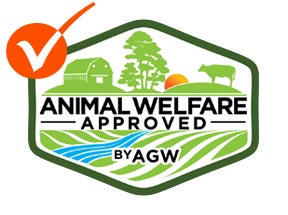
Animal Welfare Approved
A fully pasture-based animal welfare certification program, available only to smaller, independent family farms.
Strengths: Requires continuous access to pasture or range for all animals. Feedlots, cage confinement, added hormones and subtherapeutic (preventative or growth-promoting) antibiotics prohibited. Standards extend to breeding animals, transport and slaughter. Standards ensure higher-welfare breeds for animals. 100% compliance verified by auditors on every farm every 12 months.
Limitations: Focus on small farms makes it difficult for larger retailers to consistently offer AWA-certified products, but they often are found at farmers markets and smaller retailers/co-ops.
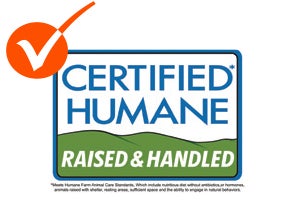
Certified Humane ®
An animal welfare certification program that includes both enriched indoor and free-range/pasture-based standards, available to farms of all sizes and structures.
Strengths: Requires continuous outdoor access for ruminants (cows, goats, sheep). If animals are raised indoors, more space, bedding and enrichment are required than is typical on conventional farms. Cage confinement, added hormones and subtherapeutic antibiotics prohibited. Standards extend to transport and slaughter. Many Certified Humane brands/farms are widely available from larger retailers.
Limitations: Outdoor access not required for birds and pigs. Unless the words "free-range" or "pasture" also appear on the package, assume pork, poultry and egg products come from farms without outdoor access. Feedlots for cows permitted for limited periods, with standards for space, shade and windbreaks that are lacking on conventional feedlots. Standards do not extend to breeding animals, nor do they ensure higher-welfare breeds for animals, including broiler chickens.1 100% compliance verified by auditors on-farm every 12 months, except for Certified Humane "producer groups" and "beef marketing groups," wherein participating farms conduct a percentage of their own audits. It is not possible to determine which products are from "producer group" or "beef marketing group" arrangements.
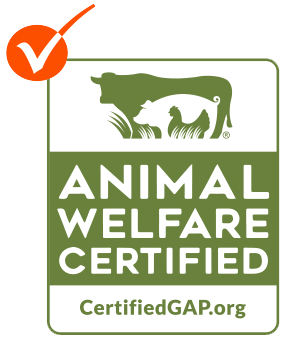
Global Animal Partnership® (G.A.P.)
An animal welfare certification program that includes both enriched indoor and free-range/pasture-based standards, available to farms of all sizes and structures, except dairy farms. The program has a six-level rating system where each successive level represents progressively higher welfare and includes all the requirements of those below it.
| Level 1 | Cages and crates prohibited. Animals can be kept fully indoors or on feedlots. Environmental enrichments required for some species. |
| Level 2 | Animals kept indoors, environmental enrichments required for all species. |
| Level 3 | Continuous outdoor access required. |
| Level 4 | Continuous access to pasture required. Feedlots prohibited. |
| Level 5 | All physical alterations prohibited. |
| Level 5+ | Animals must spend entire lives on one farm. Off-site transport prohibited, including for slaughter. |
Strengths: Levels 3 and above require continuous outdoor/pasture access. If animals are raised indoors, more space and bedding are required than is typical on conventional farms. Cage confinement, added hormones and subtherapeutic antibiotics prohibited at all levels. Standards extend to breeding animals, transport and slaughter. 100% compliance verified by auditors on every farm every 15 months.
Limitations: Levels 1-2 do not require outdoor access. Level 1 requires enrichment for some, but not all species raised indoors. None of the levels currently ensure higher-welfare breeds for animals, but G.A.P. will implement new broiler chicken standards for all levels by 2024. Producers can use a basic G.A.P. label without a corresponding level number on their products, making it difficult to identify (consumers must look for separate language on the package identifying the product's level). G.A.P. products are still mostly found in Whole Foods Markets, but are expanding into other retailers.
Other Certifications
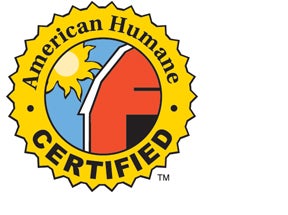
American Humane Certified™
An animal welfare certification program that includes both indoor and free-range standards, available to farms of all sizes and structures.
Strengths: If animals are raised indoors, more space is required than is typical on conventional farms (but still less than in other animal welfare certifications). Prohibits added hormones. Standards extend to breeding animals, transport and slaughter.
Limitations: Outdoor access not required for any animals and enrichments not required in indoor housing. Does not prohibit cage confinement or subtherapeutic antibiotics. Feedlots permitted, with standards for space, shade and mud that are lacking on conventional feedlots. Standards do not ensure higher-welfare breeds for animals. Compliance verified by auditors on every farm every 12 months, but only 85% of the AHC-defined non-essential standards must be met to pass inspection. Therefore, it is not possible to know which standards a certified farm is actually meeting.
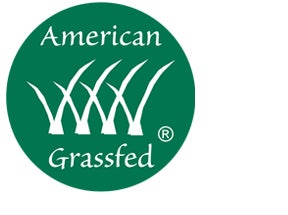
American Grassfed Association®
A grass-fed certification program with pasture-based standards, available to farms of all sizes and structures.
Strengths: Requires continuous access to pasture for all animals (cows, goats, sheep and pigs) and a diet of 100% grasses. Feedlots, cage confinement, added hormones and subtherapeutic antibiotics prohibited. 100% compliance verified by auditors on farm every 12-15 months.
Limitations: No dedicated animal welfare or handling standards and standards do not extend to breeding animals, transport or slaughter, nor do they ensure higher-welfare breeds for animals.
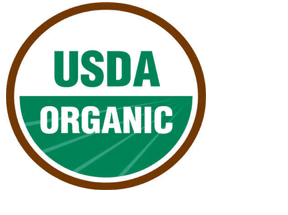
USDA Organic
An organic certification program that requires outdoor access for animals, but does not properly enforce that requirement, and is available to farms of all sizes and structures.
Strengths: Added hormones and subtherapeutic antibiotics prohibited. Compliance is verified by auditors on every farm every 12 months, but enforcement of key standards, such as outdoor access, varies widely.
Limitations: Claims to require outdoor access, but space, duration and quality of that access is not defined and varies widely between farms. (For example, access to screened-in porches on hard, concrete flooring qualifies as "outdoor access" for egg-laying hens.) Does not prohibit feedlots, cage-confinement, set minimum space standards or require enrichments when animals are indoors. Standards do not extended to breeding animals, transport or slaughter, nor do they ensure higher-welfare breeds for animals.
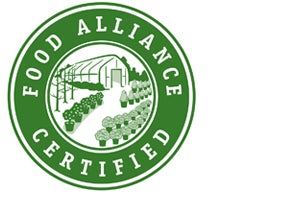
Food Alliance Certified ™
A sustainable agriculture certification program that includes both indoor and free-range/pasture-based standards, available to farms of all sizes and structures.
Strengths: Cage confinement, added hormones and subtherapeutic antibiotics prohibited. Standards extend to transportation. Certified producers must commit to continually improving practices.
Limitations: Outdoor access not required for any animals. Does not prohibit feedlots or require enrichments when animals are indoors. Standards do not extend to breeding animals or slaughter, nor do they ensure higher-welfare breeds for animals. Compliance verified by auditors on every farm, but only every three years. Producers only need to average a score of 3 out of 4 on the Alliance's non-fixed animal handling and welfare standards to pass inspection. Therefore, it is not possible to know which standards a certified farm is actually meeting.

One Health Certified
An industry-created certification program that claims to address animal welfare, human health and environmental protection, but is essentially an industry marketing tool. The program is currently limited to chicken and turkey products.
Strengths: None
Limitations: This program lacks adequate animal, human or environmental health standards or oversight, despite claiming these issues as core principles. The OHC standards allow producers to choose among American Humane Certified™ certification or voluntary industry guidelines set by either the National Chicken Council or the National Turkey Federation. All three options reflect conventional, industrial practices and do not ensure higher-welfare for animals. By aligning with these programs, OHC does not require meaningful stocking density limits, lighting schedules, environmental enrichment or healthy breeds, all of which are key components of improved poultry welfare. In addition, OHC allows for routine use of medically important antibiotics for disease treatment and control, without addressing the underlying causes of disease, including poor welfare.
Supermarket and Restaurant Request Letter
Egg Comparison Guide
1As of 2024, the ASPCA will only recognize chicken welfare certifications that require better breeds.
Source: https://www.aspca.org/shopwithyourheart/consumer-resources/meat-eggs-and-dairy-label-guide
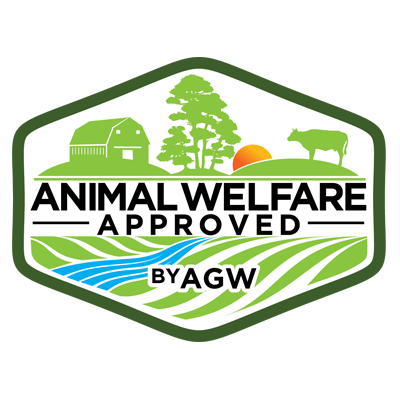






0 Response to "Does Hormine Enriched Beef Have Issues Charring"
Post a Comment